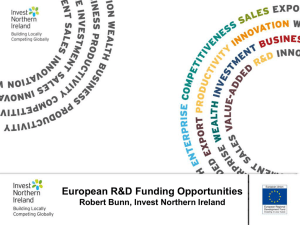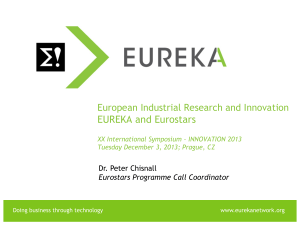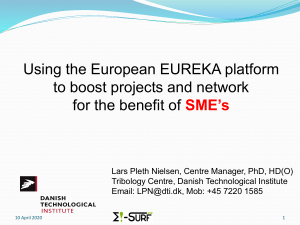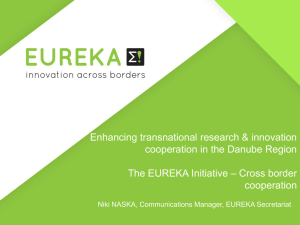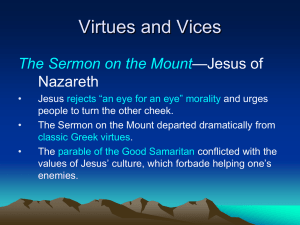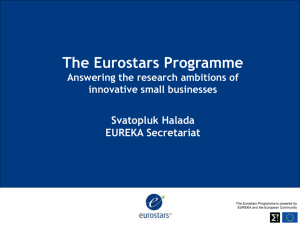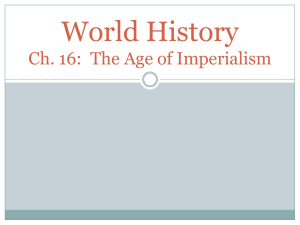Eurostars
advertisement
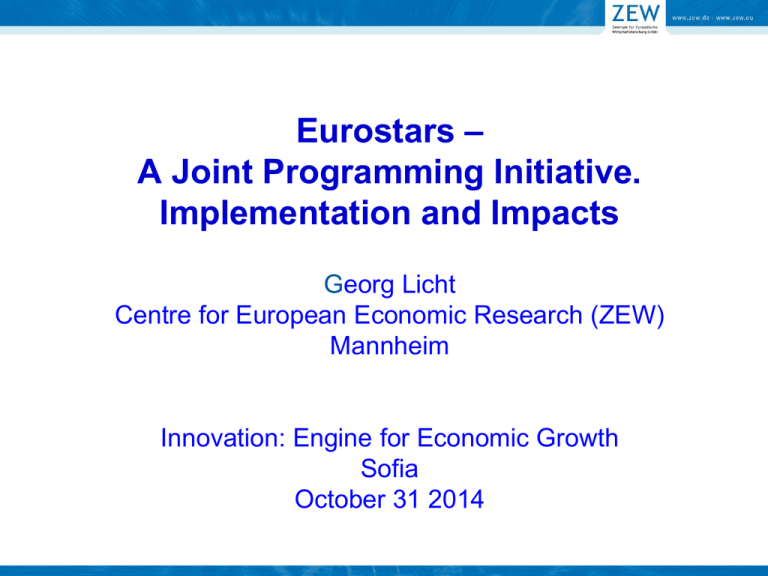
Eurostars – A Joint Programming Initiative. Implementation and Impacts Georg Licht Centre for European Economic Research (ZEW) Mannheim Innovation: Engine for Economic Growth Sofia October 31 2014 Agenda What is Joint Programming? What is Eurostars? Virtues and Vices of Eurostars Potential Impacts What is Joint Programming? R&D programmes jointly financed and governed by the European and the level of member countries of the EU Article 185 of the Treaty on the Functioning of the European Union (TFEU) = Lisbon Treaty “In implementing the multiannual framework programme, the Union may make provision, in agreement with the Member States concerned, for participation in research and development programmes undertaken by several Member States, including participation in the structures created for the execution of those programmes”. Joint Programming - Examples FP6 2002 bis 2006 European and Developing Countries Clinical Trials Partnership (EDCTP) FP7 2007-2013 Ambient Assisted Living (AAL) Eurostars European Metrology Research Programme (EMRP) Joint Baltic Sea Research Programme (BONUS4 Joint Programming – Examples II Horizon 2020 (FP“8“ 2014-2020) Alzheimer and other Neurodegenerative Diseases (JPND) Agriculture, Food Security and Climate Change (FACCE) A Healthy Diet for a Healthy Life Cultural Heritage and Global Change Urban Europe - Global Urban Challenges Connecting Climate Knowledge for Europe (CliK’EU) More Years, Better Lives Antimicrobial Resistance – The Microbial Challenge Water Challenges for a Changing World Healthy and Productive Seas and Oceans What is Eurostars? Programme to foster R&D in SMEs in member countries of EU and several associated countries (Switzerland, Israel, Norway, Iceland, Turkey) Near-market research (two year till product/service introduction in the market after project end) Lead partner: R&D intensity >10% (R&D spending/turnover or R&D employees/total employment) Minimum: 2 partners from 2 participating countries Partners: Firm of any size; universities; public research institute Bottom-up approach open to all technologies and all industries Project: <3 years; typical size of EUR 0.8-2 million Joint Programming in Eurostars EU fund from FP7: up to EUR 100 million conditioned on a contribution from member states of EUR 300 million; Hence, EU share is not more than 25% Responsible for implementation: EUREKA Centralised evaluation and decentralised funding decisions (each country finance only participants from their country) Internet-based application via EUREKA website; 2008-2009: One call per year; 2010-2013:Two calls per years Evaluation by two technical experts (different countries, excluding the home countries of applicants) Quality-based ranking of all projects by evaluation panel (Ranking list) Project Ranking and Funding in Virtual vs. Common Pot System Virtues and Vices of Virtual vs. Common Pot System Positiv: Incentive effect for national funding provision Each country only fund participants from there own country (and receive a top-up on its own resources out of EU funds) Each country can select the amount of money it can afford to fund R&D in SMEs cooperating with international partners Learning from partner how to best fund SME R&D projects International platform for competition on the best available SME R&D projects Negativ: High coordination effort needed Potential Impacts Innovation in new products / services / process Improvement of IP position Improve EU wide visibility Ease market excess to large markets in Europe through collaboration in the R&D phase and also the market introduction phase Easy funding procedure and quick decision on technical quality of project Relative small effort need for development of the proposal Technological openess allows for high flexibility in content of the R&D project
